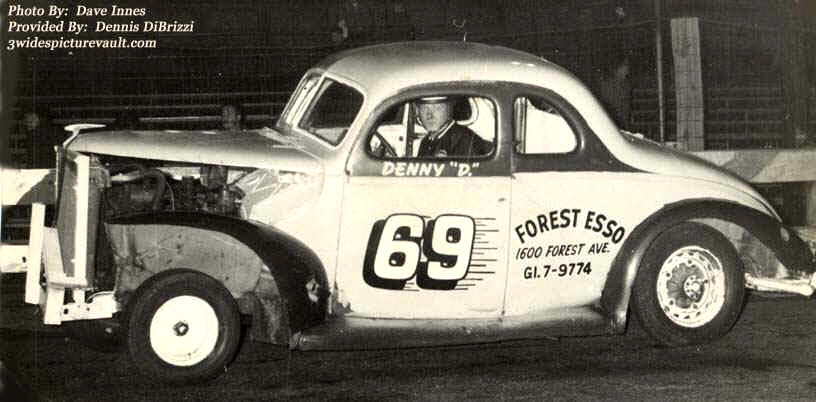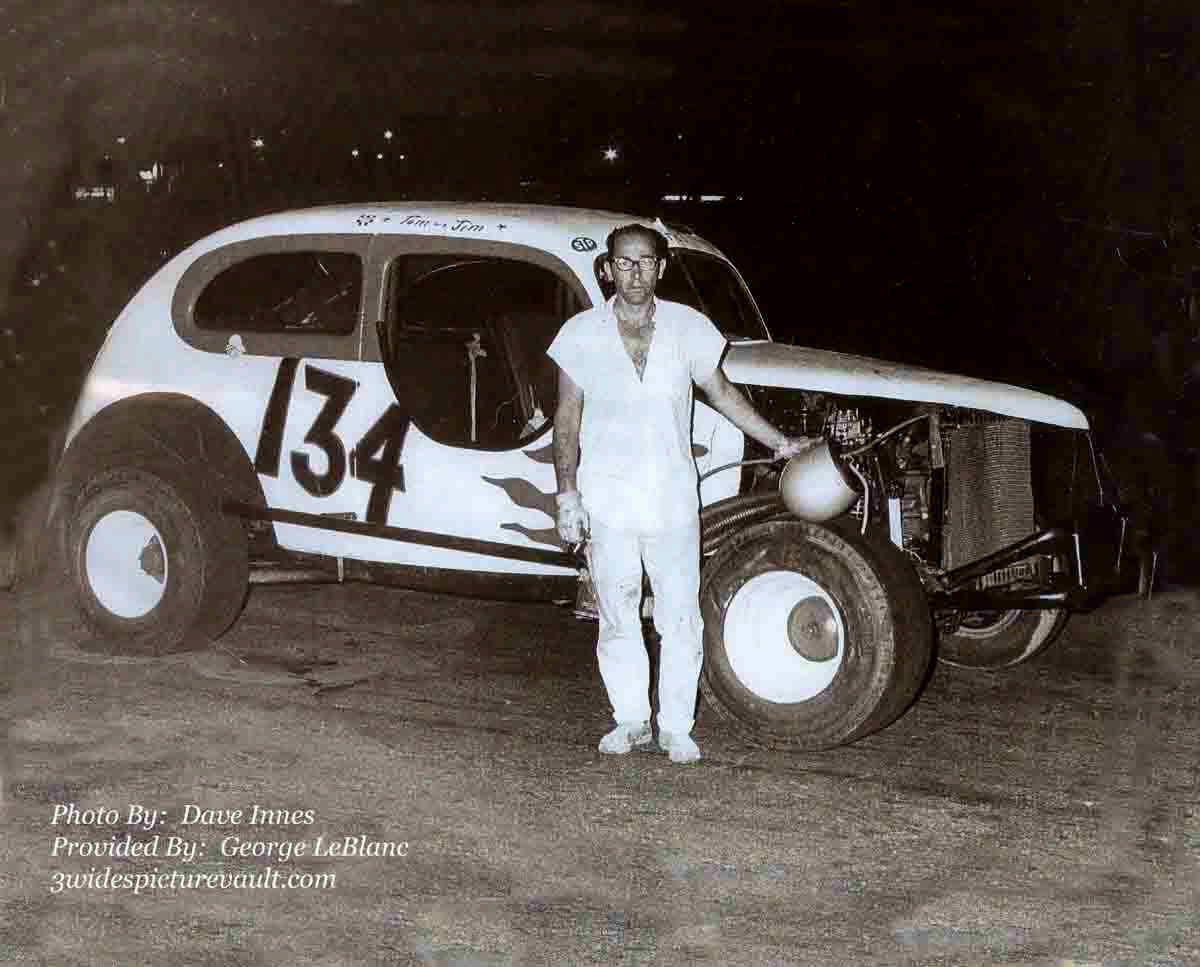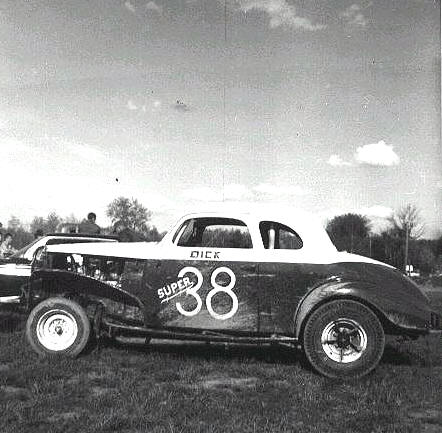Curt Giventer paces the pack at Airborne in 2008. [Courtesy of Curt Giventer]
THE
BILL'S BACK IN TIME COLUMN PAGE
Copies of my column in Mark Thomas' "Racin'
Paper"
BILL’S BACK IN TIME
By Bill Ladabouche
Column 67 - From Original Column 82
THE METAL MAN COMETH
Weisglass Stadium was a track on Staten Island that I just happened to stumble onto, once in my life. My aunt and uncle had taken me [around eleven years of age] to visit her aunt, and we noticed a stock car being towed by just about the time we were to pull off, onto Aunt Selma and Uncle Bill’s street. We found out where the races were, and proceeded out to Port Richmond to see them because he and I had not been to a real race in a matter of years.
As I mentioned in previous columns, Weisglass Stadium [named for a nearby dairy] was a Depression – era WPA project made primarily for sporting events such as baseball. The stadium was also home to concerts and various shows, including horses. The configuration offered room only for a fifth – mile, totally –round paved track. The neighborhood was rough, and the participants were even rougher.
From this atmosphere came a young man named Curt Giventer, a stocky, powerful man was ran at Weisglass for years before leaving the City for a new life in the Adirondacks, near Saranac Lake. With his salvage and wrecker service notwithstanding, Curt is known around the Airborne Speedway as “Metal Man”.Curt actually has metal somewhere in his body as a result of some accident in the past. He appears, somewhat regularly, at Airborne Speedway with an old East Windsor Speedway sedan numbered 2.
Curt Giventer paces the
pack at Airborne in 2008. [Courtesy of Curt Giventer]
The big old sedan was built by a Great Lakes tugboat captain named Richard Downing, who had retired off the lakes to Staten Island about the time Giventer was wanting to move up to a better division. The sedan, a modified of sorts, came after years of Curt racing in a lower division at Weisglass. Giventer could hold his own in the rough – and – tumble hobby division because he speaks of having nicknames such as “Wild Curt” and Curt the Animal”.
Curt talks about the pecking order in the Weisglass pit areas back in those days of the 1960’s. Memali Chrysler / Plymouth was located outside, right in front of Weisglass Stadium, and a paved portion of its new car display lot was given over to the track’s “good cars”, as Curt puts it. The hobby and jalopy classes had to pit near Brae Brook, in a darkly – lit dirt section. It was easy to get beaten up or have your car vandalized in that pit area. To this day, Curt checks his car much more than is really necessary because of this experience.
Red Hammersly was the Weisglass flagger, and he handed Curt his first checkered flag in 1967. The track, located near the Bayonne Bridge, was the home to a racing family called the Leandros. The sons were Frankie, Pete, and Art, all of whom raced [when not fighting with someone]. The father, Pop Leandro, was in charge of the jalopy pit area. Wearing a red satin jacket and brandishing a flag for authority, Pops was the ultimate judge of who [and when] went through that pit gate. A disagreement with Pops meant a disagreement with at least one of the boys, as well.
Wild Curt picking up a checkered flag at Weisglass. [Courtesy of Curt Giventer]
Curt has some specific memories of his days at Weisglass. One time, when he on the outs at home, he had his race car garaged at another guy’s house. He would have to use the train or a bus to get there and work on the car. He ended up actually living in the back of that garage for a while. He recalls the rush hour, when all the boys were trying to get their heaps to the track for a Saturday night’s run. As Curt describes it” cars towed in on ropes and chains, flat-towed, stiff-hitched, or came on half-assed trailers. Some would actually just drive the car there.”
For a while, Weisglass used to run two nights a week, but it would only come alive on a Saturday night. Port Richmond was the main shopping venue for everyone on the Island, and this fact meant that any other night was not going work really well. Dave Rispoli, a tough little Italian with a great big cigar, was the early promoter. The stadium was originally going by the name Brae Brook Stadium, and when Dave took over the named was changed to Weisglass Stadium “for an undisclosed sum of money from the Weisglass dairy”. Rispoli developed the track into a consistent program, described by Giventer as “round and round in brightly – painted, unsafe, loud jalopy cars”.

Dennis DiBrizzi poses in
a typical Weisglass car. Note the tiny inside wheel.
[Weisglass Memories Site]
Curt always described driving at Weisglass as “a lot like driving a bulldozer, only faster”. And he points out that you had to be able to fight to survive there. Some of the stadium’s better – know stars included Bruno Brackey, George Kaufmann, Howie Brown, Tony Milano George LeBlanc, Al Lucky, Buddy Laureno, Jiggs Cunningham, and Charlie Edkins. The pits were full of colorful characters, like Gene Salfelder, who chomped on a huge cigar while helping out the little guys like Curt and his hobby class buddies. The track welder, Lucky, sold welding insurance to competitors on a weekly basis for $3. Giventer says it was well worth it in the long run.
Weisglass eventually moved over to progress, as happened to most old fixtures in the New York City area. Its heritage is unquestionable and its legacy lives on with guys like George LeBlanc and by avid defenders like Curt Giventer, the Metal Man of Airborne Speedway.
On another front, I recall that, for a few weeks during C.J. Richards’ first year at Fairmont, the track offered pizza in the concession area [which. Typically for those days, was pretty humble].One particular afternoon, a thin guy with a cigarette dangling out of his mouth walked in front of the grandstands carrying one of the newly-offered pizzas into the pit area across the track in the infield.

George LeBlanc, one of
the best at Weisglass Stadium. [Weisglass Memories Site]
Had the track announcer not happened to sue this opportunity to push the new pizza sales. When he mentioned that the happy customer was, in fact, driver Art Rivers – it was the first time I had ever been able to put a face with that name in the car # About5. It occurred to me, even at that tender age of around 14, that only the more prominent drivers were familiar to the fans and that perhaps 70% of the guys laboring out there every week were nearly anonymous – except to family and neighbors in the stands.
Eastern New York was a particularly rich resource of these little-known racing teams, many of whom had quite a long history behind them. The state had already seen a ton of little race tracks by the time Richards re-opened Fairmont in 1962. Just a few of these included Ashland Park, Warrensburg, NY; Empire Speedway, Menands, NY; Whites Beach Speedway, Ballston Lake, NY; Mettawee Speedway, North Granville, NY; the Schuylerville, NY track; Champlain Speedway, Ticonderoga, NY; Airborne Speedway, Plattsburg, NY; the West Glens Fall track; Burden Lake Speedway, the Pine Bowl, Snyders Corner, NY, and many more.
Racing at most of these little hole-in-the-wall ovals developed two types of teams: teams like Spence Parkhurst and Steve Danish, who developed into semi-professional efforts, touring to various tracks and attaining enough expertise to rise up to the big-time tracks like Fonda, Stafford Springs, and Lebanon Valley. The rest of the teams a vast majority] either stuck to one track or raced inconsistently at a few tracks. It was many of the latter teams that populated Fairmont’s pits in 1962, as they had at Otter Creek the year before.
Art Rivers flies over the
picket fence as nervous officials look on. [Courtesy of Wes Moody]
Art Rivers was a kind of poster boy for all those legions of anonymous teams who showed up as often as they could, wherever they could, and who seldom got to touch a checkered flag – even in a heat. Rivers’ fragile-looking little ’34 Ford coupe, numbered “About 5” [for some reason known only to his team] was an unsponsored little white car with whatever tires they could scrape up. The Glens Falls – based bunch would stiff hitch into Fairmont on a fairly regular basis.
The Glens Falls bunch also included the pudgy Tommy Clark, Art’s brother Lee, and a former Fonda driver named Earl “Little Joe” Spellburg. Many of these guys had run Ashland Park and Whites Beach, and they often interchanged cars – except for Spellburg, whose 1940 Ford, the Roadrunner #7 was their cream of the crop. The car, a former Johnny Jones car from Ashland Park, was considered one of Fairmont’s nicer cars. Once Fonda driver George Baumgardner hopped in the sedan and won a Fairmont feature handily.
The Rivers About 5 met its demise at the Rutland Fair, during that infamous Sunday afternoon show, when Phil Russell’s enormous yellow and black Hudson, The Checkmate, shoved Art out of the way on the front stretch, piling it over the little white picket fence. It scared t he hell of the officials in the announcer’s stand, and signaled the end of Art’s little car. Spellburg sort of disappeared by the following year and the #7 was listed as being driven by Tommy Clark – but it didn’t show up much.
Corinth,
NY’s Leon Shaw was
another typical low-dollar operation. He once used dual tires
on the rear to compete with others’ racing slicks. [Ladabouche Photo]
The Glens Falls gang began to slip away, probably due to lack of finances. The other group of New Yorkers, the bunch from Warrensburg, apparently had more money and they continued to participate well into the 1964 season. Ed Baker had his yellow Hudson coupe, a regular feature winner. The 6PAC, owned by Vern Baker was the former car of legendary Wally LaBelle. Dick Pennock was another Warrensburg driver with seemingly plenty of racing money. His Super 38’s, once driven at Mettawee, were quality cars.
A few other little New York teams stayed the course, but – for the most part – they gradually slipped away. The New Hampshire invaders like Buddy Bardwell, Art Cody, Ted Brown, Cecil Bosworth, and Sonny Rabideau were taking the lion’s share of the Fairmont purses, and locals like Ed Foley and Vince Quenneville, as well as George Rogers, were beginning to take home the purses, as well. By 1965, when the track offered V-8 sportsman cars, the New York contingent had switched to Fonda and Valley regulars looking for an easier purse to win.

The Pennock cars were always good lookers. [Ladabouche Photo]
Most of the Art Rivers – type drivers had disappeared from the scene, victims of shallow pockets and empty wallets. The Warrensburg crew also faded away, with only Pennock continuing into the more expensive racing of 1965. A young Ralph Palmer would take a year at Fairmont before going to work for Dexter Dorr, but – from that point on – most of the old boys from the ghost tracks like Whites Beach and Ashland Park were gone forever.
If you are a regular or occasionally visitor to my website, I apologize for its lack of updating. I am having terrific problems with my internet service, and cannot seem to catch a break getting it rectified. Hang in there, and I’ll be back.
Return
to the Main Page
Return to the Main News Page
Return to the Columns Link Page
Return to the All Links Page